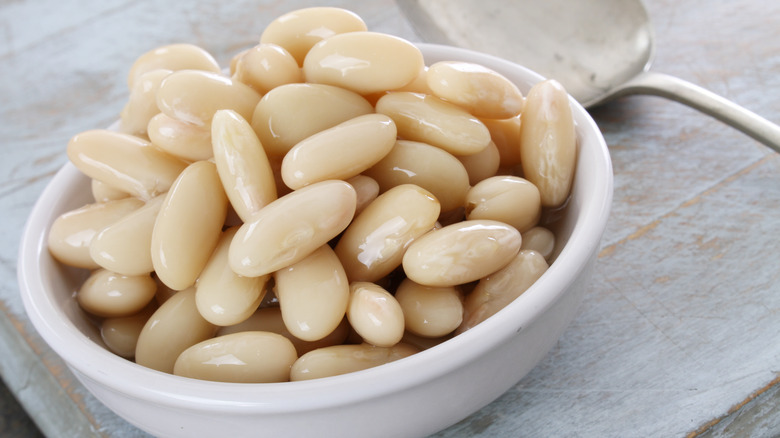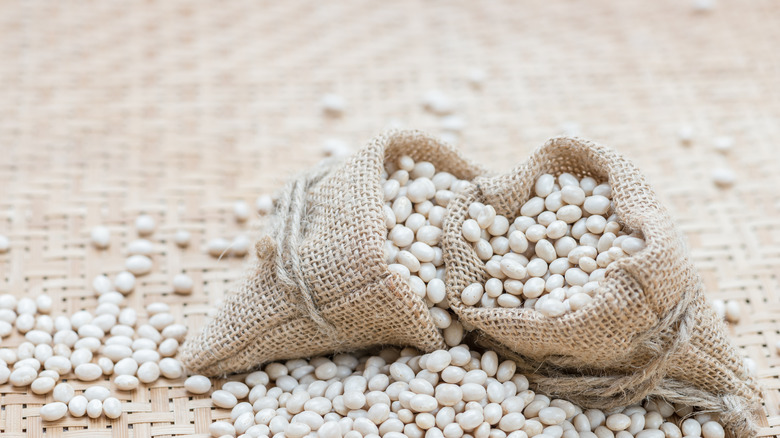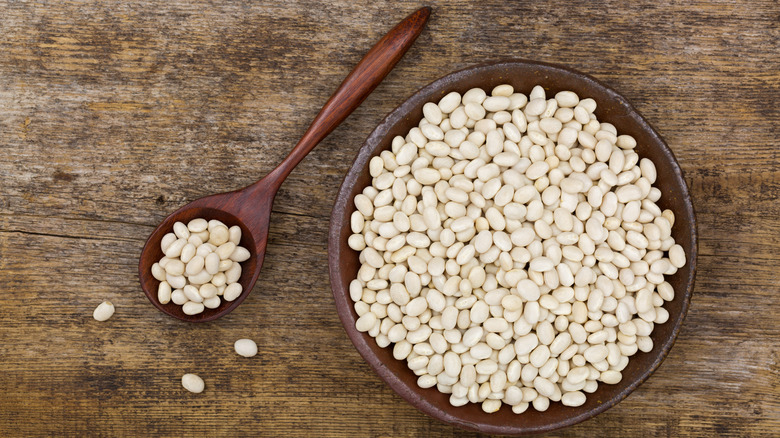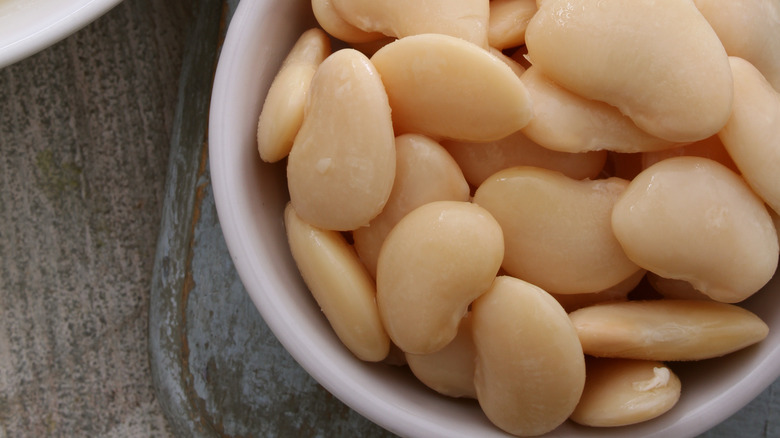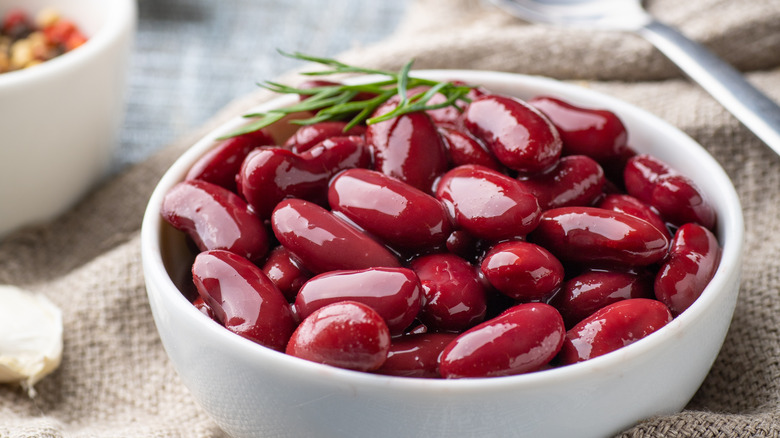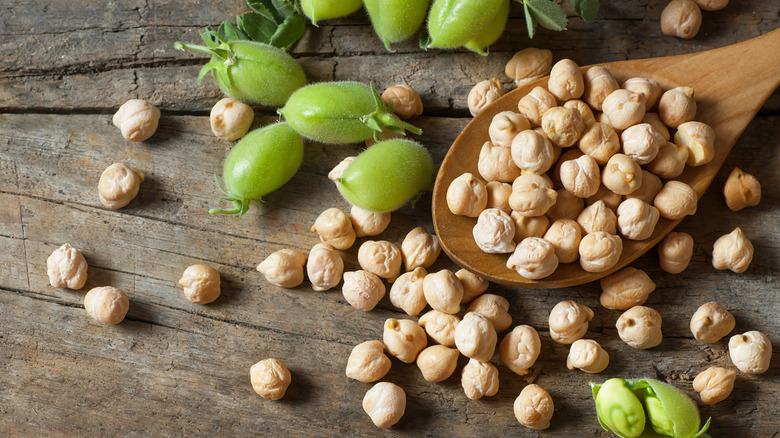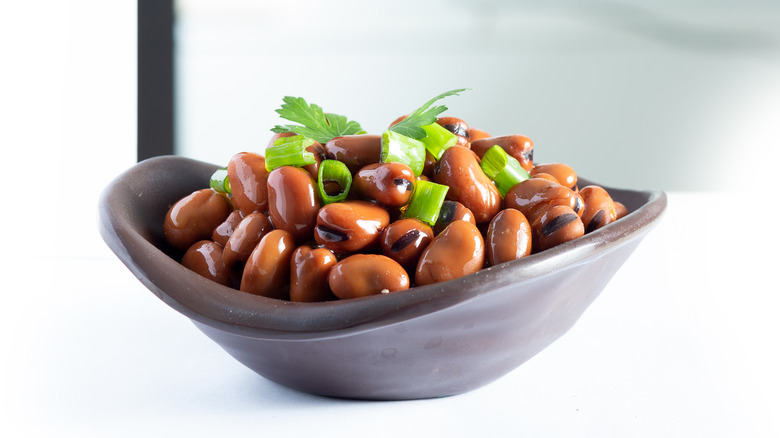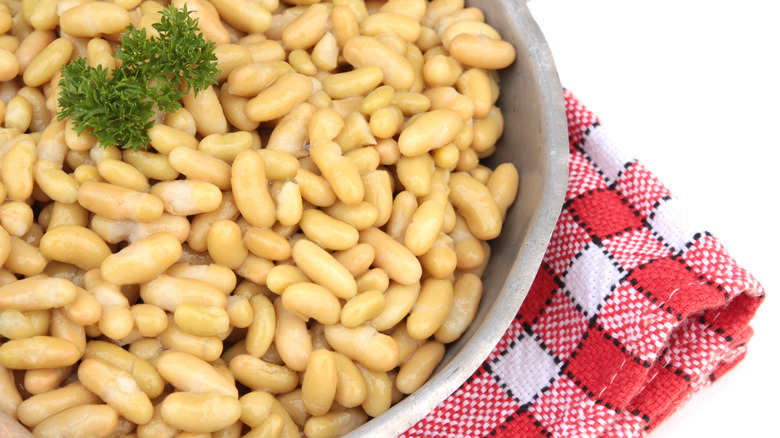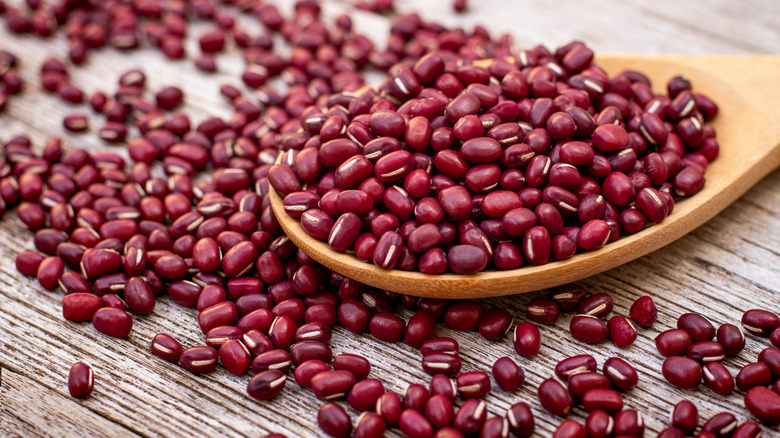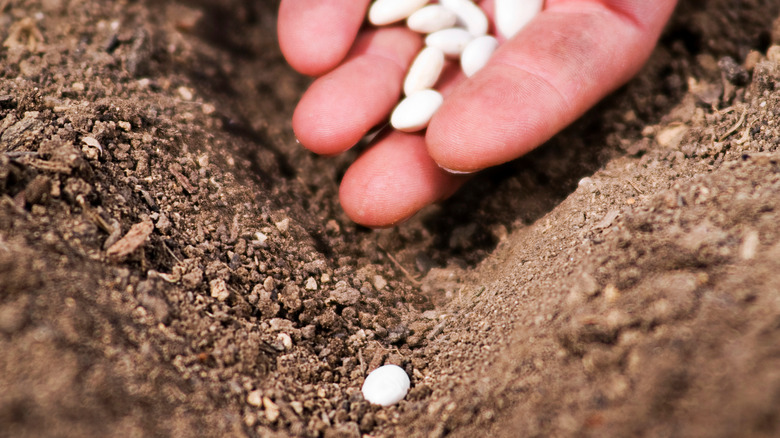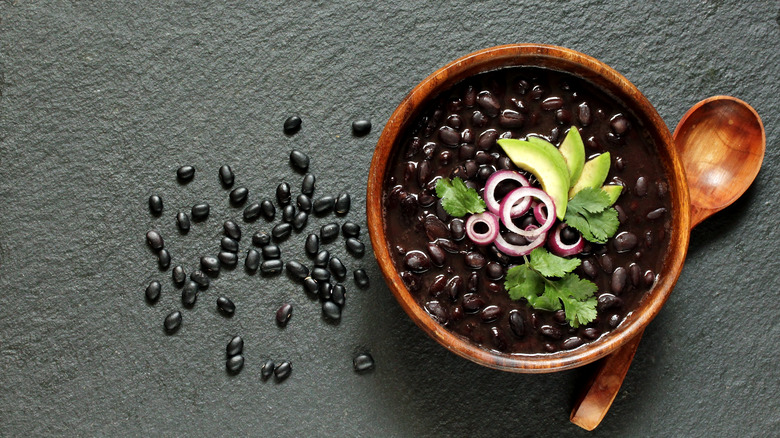10 Best Substitutes For Cannellini Beans
The cannellini bean, also known as the white kidney bean in English speaking countries, as the lobia bean in India, and by other names in other places, is a member of the Phaseolus vulgaris family (via Missouri Botanical Garden). Its most common name ("cannellini," e.g.) is Italian, and the bean is popular in Italian cooking, especially in cuisines from the central and southern regions of the country. The bean is not native to Southern Europe, however: white kidney beans are believed to have originally been from the land that is now Peru, according to Cannellini.com. They were then heavily cultivated by Italian immigrants who settled in Argentina, and were introduced back to Europe in the 1500s, soon finding their way deep into the culinary tradition of many nations even beyond Italy.
The cannellini bean is often used in soups, with pastas, in salads, and beyond. It is prized for its subtle, nutty flavor and its readiness to take on the flavoring of other ingredients used in a dish, from red tomato-based sauces to salt and butter flavors to spices and more. Beyond their great favor and texture, these beans are also prized for their health benefits. According to Healthline, cannellini beans are high in protein, with 17 grams per one cup serving, while being quite low in fat, with a mere 0.6 grams of fat per that same serving size. They are high in fiber, a great source of myriad vitamins and minerals, and they are quite shelf-stable, too.
All that said, if you ever find yourself without these celebrated beans on hand, there are plenty of options you can substitute for cannellini beans. Here are 10 good choices.
Great northern beans
Great northern beans are about as close as you can get to the cannellini bean. While slightly smaller than cannellini beans and slightly milder in flavor, they have a nutty taste similar to their larger, popular counterpart and they can be used interchangeably in just about every dish you will ever make with a cannellini bean. Great northern beans are known for their firm flesh, according to Camellia Brand, so they hold their shape well during cooking, making them a great choice for use in slow cooked dishes like soups or stews that are not blended or pureed.
Also often called simply "large white beans," great northern beans, like their "Italian" counterparts, are high in protein, low in fat, high in fiber, and a great source of many nutrients, according to Spoon University. Because the flesh of the great northern bean is a bit tougher than that of a cannellini bean, the only difference you need to account for when using them as a substitute is to increase cooking time (or soaking time) slightly if you are trying to create a verisimilitude of the cannellini bean.
The name "great northern bean" comes based on the heavy cultivation of these healthy legumes by the Mandan Tribe of native peoples (who self-identified as the Numakiki, it should be said) who lived primarily in lands that are now the state of North Dakota, according to Britannica.
Navy beans
Navy beans are also called pea beans due to their rather small size and rounded shape, though like most white beans they are ovular, not circular. According to Leaf, these beans got their more common monicker due to the fact that they were indeed used in large quantities by the United States Navy starting in the second half of the 19th century and lasting well into the 1900s thanks to their very stable storage life and their nutrient density, both of which were invaluable during sea voyages.
Unlike great northern beans and more like cannellini beans, navy beans have relatively tough skin and dense flesh, so they are ideal for use into make foods like Boston baked beans, pasta e fagioli soups, pork and beans, and other dishes where the chef wants the beans to hold their shape. That said, navy beans can of course be pureed for dips, soups, and more. Due to their tougher skin and flesh, navy beans can require cooking times (boiling specifically) that are much longer than with cannellini beans, when cooked from a dried state. Even with overnight soaking, navy beans may need at least an hour and a half of boiling to reach a proper tenderness, according to WH Foods. But once properly cooked, navy beans can be swapped in for cannellini beans in almost all recipes.
Butterbeans
Also known as the mini lima bean, the sieva bean, the wax bean, and by other names as well, the butterbean (or butter bean, as they are often called with the two words separated, per Leaf TV) is essentially the exact same thing as the lima bean, save for one notable difference: according to Heal With Food, the notably green lima bean common in the United States has its green color because it is intentionally harvested while still immature. At full maturity, the lima bean/butterbean is white and has a more tender texture and creamier taste. In this state, butterbeans can be used in place of cannellini beans in almost every dish and recipe, though they are slightly starchier than the cannellini, and have less of that nutty flavor.
Butterbeans are so named for the rather buttery flavor and texture they yield when prepared well. "Plump and creamy when fully cooked, they do in fact have a butterlike texture that is very appealing," according to the Tampa Bay Times. "Butter beans don't have a ton of flavor, so they're best when pumped up with some fat, particularly bacon or ham."
(And yes, "Butterbean" is also the nickname and professional/stage name of Eric Scott Esch, former boxer, kickboxer, and mixed martial artist, not to mention professional wrestler, who, according to Sports Casting, tipped the scales at more than 400 pounds when in the heyday of his career.)
Kidney beans
Kidney beans are a wonderful substitute for cannellini beans because they are nearly identical in terms of their size and texture and how they handle in dishes. They cook the same way, they break down and mash the same way, and they puree down all just like cannellini beans. Where they differ some is in flavor: according to Leaf, kidney beans have an earthy, almost red meat-like flavor that is distinct from the cannellini bean. So in dishes where the beans themselves will be easy to taste, kidney beans are a decent substitute, but not a great one. However, even the more robust flavor of the kidney bean does not mean it will not readily take on other flavors, so in dishes with a decent dose of spices or butter or other strong flavoring, kidney beans are a great stand-in. These beans, the kidney and the cannellini, also go great together in bean salads, chilis, green salads, soups, dips, and more.
In terms of nutrition, kidney beans are also good comps to the cannellini bean. A one cup serving of cooked kidney beans has about 17 grams of protein, 13 grams of fiber, only around 270 calories, and just a bit more than a gram of fat, according to Healthline. Kidney beans are also a great source of folate, potassium, iron, vitamin K1, and other essential nutrients.
Garbanzo beans
Garbanzo beans are impressively versatile. Also commonly called chickpeas, they can be used to make everything from hummus to falafel to bean burgers, and of course they are delicious and nutritious eaten on their own. While they have a markedly different shape and texture from the cannellini bean when whole, the garbanzo bean is a great substitute for the cannellini bean in recipes where they will be heavily broken down, according to Foods Guy, as they have a similar nutty flavor and almost match the cannellini bean in terms of color.
Garbanzo beans do have a skin that should be removed if they are going to be used in place of the cannellini, however. Once cooked, or when they are used out of the can (or box, as is common these days), these skins can be easily removed by rubbing the beans between the fingers and then rinsing away the semi-translucent casing that slips right off. When cooked from their raw, dried state, garbanzo beans take quite a while to achieve the proper, desired tenderness — allow for at least two hours of slow simmering of dried garbanzos even after they have been soaked. In terms of nutritional value, these legumes are quite impressive. According to Healthline, a single ounce of garbanzos has three grams of protein (thus 24 grams for an eight ounce, or one cup serving), two grams of fiber (or 16 per cup), and they are a great source of folate and manganese.
Fava beans
Also commonly called broad beans and sometimes called faba beans, fava beans, according to Healthline, "pack an incredible amount of nutrients." They are high in protein, very low in fat, a good source of folate, copper, iron, and magnesium, and they are good for the immune system and for bone health. And in recipes where they will be well cooked and blend into the dish, such as in soups or stews, they are a great one-to-one stand in for cannellini beans, according to My Recipes.
In terms of taste and texture, according to Foods Guy: "Fava beans are quite large, fairly dense, and very meaty. If you're making a vegan or vegetarian main dish that you want to be hearty, broad beans are a good selection. They work well in soups and salads, provided you enjoy the flavor." That flavor, which is often described as vaguely "cheesy," can, as in the case with most beans, easily be overridden by ingredients with potent flavors of their own, such as onions and garlic, chilis, salt and butter, or other foodstuffs, so despite being a bean with more taste than many others, the fava bean is by no means going to overpower your dish.
Do note that some people have a health issue called "favism," according to the Food Allergy and Research Program of the University of Nebraska, which can cause "symptoms that include pallor, fatigue, dyspnea, nausea, abdominal and/or back pain, fever, and chills."
Flageolets
If you're less than familiar with the flageolet bean, that's entirely understandable, as they are not all that common outside their native France. But once you have tried them, you'll deem them not only a fine substitute for cannellini beans in any and all recipes, but perhaps in fact your new go-to. According to The Spruce Eats: "A pale shade of green, flageolet beans are sometimes known as the 'caviar of beans' because of their subtle flavor and the high esteem in which they are held by food lovers." The taste is mild and creamy, much like the cannellini but richer, and they readily drink on flavors of other ingredients in the dish.
While a great swap for cannellini beans or other similar legumes, the only major drawback to note from the flageolet is their relative rarity outside Europe and, not surprisingly then, the elevated price that often comes along with them, especially if you are buying them fresh. Some American farmers do grow varieties if flageolets, especially in California, but it's a better idea to look for dried flageolets, which you can find at some grocery stores or you can order them online. Like most dried beans, flageolets have a very long, stable shelf life when dried, so do stock up and keep them on hand if you find them as unique and appealing as many gastronomes do, both in France and beyond.
Adzuki beans
The adzuki bean, also known as the azuki, the aduki, or in many places as the red mung bean, is quite common across much of Asia, where they have been a staple food for millennia. According to Sage Journals: "Azuki beans from Neolithic contexts in Korea and Japan show a possible sign of morphological response to human management, at least 2000 years prior to the appearance of fully domesticated forms," and with domestication of these beans estimated to have occurred some 5,000 years ago, it's probable humans have been growing and eating adzuki beans for some 7,000 years. Today, they are common in many Asian cuisines thus often easy to find in speciality markets catering to Chinese, Korean, or Japanese communities. And while sweeter than the cannellini bean, they can nonetheless be incorporated into many recipes in place of the Italian bean.
Along with that sweetness comes a nuttiness not unlike the flavor of the cannellini. According to The Seattle Times: "Vibrantly colored and sweet, adzuki are commonly used in desserts in Asian cooking. But in America they often are put to savory use, mixed into salads, cooked with rice and dropped into soups." They also note that, unlike many dried beans, azuki beans don't have to be soaked ahead of time.
But like you expect with just about any beans, the adzuki is a great source of protein, fiber, and various vitamins and minerals. According to Healthline, they are particularly rich in folate, manganese, phosphorous, potassium, and copper.
Marrow beans
Marrow beans are a great substitute for cannellini beans that can be used in just about any recipe that calls for the common Italian white bean. The only issue? Marrow beans are not common — at least not anymore. According to Delighted Cooking: "These beans were also extremely popular in North America during the 1800s, when they were the bean of choice in some regions for baking," but they have since fallen out of favor, largely replaced by other varietals. They are still popular in many places, especially around the Mediterranean and, ironically, perhaps, in Italy.
Large and plump when cooked, they have a rich and creamy texture and a mildly meaty flavor that some people describe as reminiscent of the taste of pork bacon (via Local Harvest). Marrow beans will blend into dishes much like the cannellini bean, but unlike the cannellini, they are often served on their own as a side dish that has been flavored with a sauce or spices. Note that you may also hear of these beans called marrowfat beans — that is the exact same legume.
If not readily available at a grocery store, marrow beans are easy enough to order off the internet.
Black beans
Black beans are not an ideal substitute for cannellini beans for a few reasons, chiefly that their markedly different color will change the look of many dishes and the fact that they have a sweetness that is absent in the cannellini. That said, they are a fine substitute in many recipes because their texture is not unlike the cannellini, once they are crushed or pureed, and because that sweetness can be easily overridden with salt and spices. One other major reason these beans are a good stand-in? They are very easy to find. According to Ag Hires, the black bean is the fifth most common and popular bean in America (one through four are the pinto, the navy bean, the great northern, and the kidney) so you can pretty much always fine a can, bag, or box of these beans for sale nearby.
While not suited to use in all dishes where cannellinis shine, like in a pasta, black beans are fine substitutes in things like salads, stews, soups, dips, or wraps, according to Foods Guy. And in terms of health and nutrition, according to Healthline, black beans are high in protein and fiber, with 15 grams of each per one cup serving, they are rich in various vitamins and minerals, and they have only 227 calories per that same serving size.
